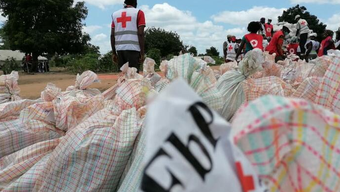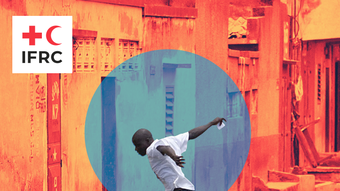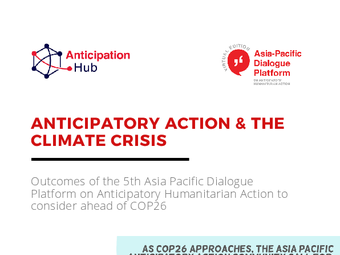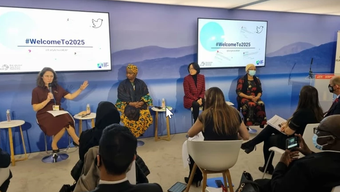A step forward for anticipatory action at COP26
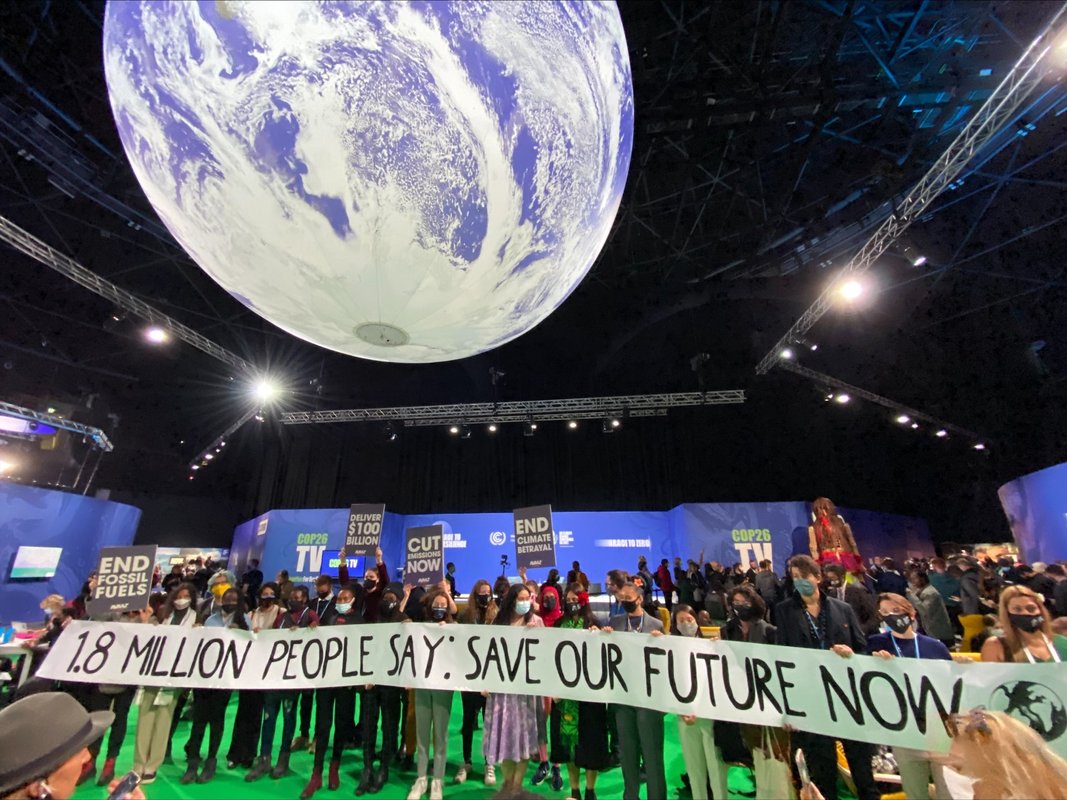
For two weeks each year, global attention focuses on the high-level COP climate negotiations. But for people living with its impacts, climate change is often a year-round struggle. Climate-related events – heatwaves, wildfires, drought, flooding, cold waves, cyclones – cause the loss of lives and livelihoods, while contributing to disease, conflict and displacement. In 2020 alone, for example, 30.7 million people were internally displaced by disasters, with weather-related events accounted for almost all of these.
Anticipatory action helps those affected by extreme events to cope with the worst impacts. And as climate-related disasters become more frequency and destructive, the humanitarian community urgently needs to scale up anticipatory approaches to help more people survive the worst effects of climate change.
It was therefore encouraging to see anticipatory action firmly on the agenda at COP26 in Glasgow. This was evident right from the start: the UK COP26 Presidency’s Glasgow Imperative outlined a desire “to see enhanced understanding of climate risk drivers, improved planning and new collaboration to close the gap between early warning and anticipatory action.”
“This COP took place at a pivotal time,” notes Ambassador Sibylle Katharina Sorg, Germany’s Director-General for Crisis Prevention, Stabilisation, Post-Conflict Peacebuilding and Humanitarian Assistance. “Even with our best efforts, climate change impacts affect the most vulnerable already. That’s why financing for mitigation and adaptation is crucial. And that’s why it was good to see anticipatory action figuring prominently in many COP debates. I am convinced anticipatory action will play an important role in adapting to climate change impacts.”
Anticipatory action on the agenda
Across the two weeks, over 40 sessions and workshops either focused on the role of anticipatory action in tackling the impacts of climate change, or discussed this approach as part of a wider debates around conflict or insurance. Common themes during these talks included the need for gender-responsive anticipatory action, more financing mechanisms, and locally led anticipatory action.
Other recurring themes across COP26 were relevant to anticipatory action as well. “Discussion around the limits of climate change adaptation - the ‘loss and damage’ debate - gained steam,” says Dr Nikolas Scherer of the Anticipation Hub. “The devasting impacts of climate extremes on lives and livelihoods will only worsen in the future. Different sectors will need to work together to address this challenge - and there is a lot that humanitarians can offer. Anticipatory action, for example, saves lives and livelihoods - and should be at the core of the loss and damage debate.”

© Scherer/ GRC

© Scherer/ GRC
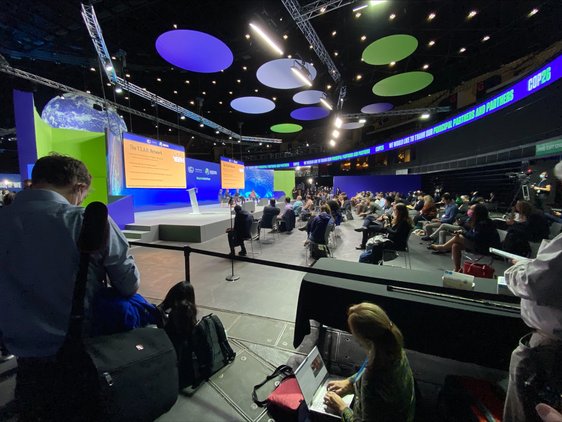
© Scherer/ GRC

© Scherer/ GRC
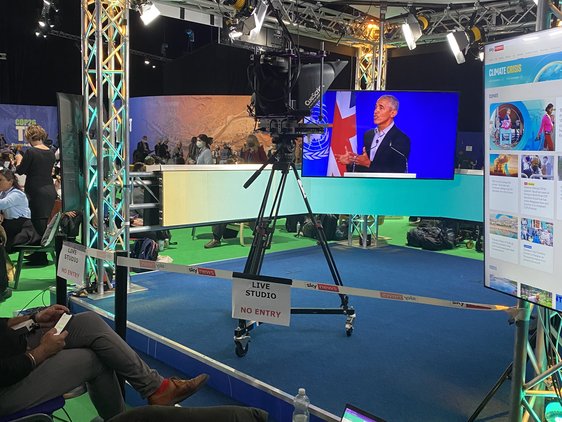
© Scherer/ GRC

© Scherer/ GRC

© Scherer/ GRC
© Scherer/ GRC
© Scherer/ GRC
© Scherer/ GRC
© Scherer/ GRC
© Scherer/ GRC
High-level commitments to fund anticipatory action
Anticipatory action requires more than just talk, of course. It also needs robust financing mechanisms to be in place before disasters hit, so that agreed early actions can be implemented swiftly. COP26 delivered good news here as well.
During the conference, REAP kept track of financial commitments made that were made or reiterated at COP26; not all the amounts are fully dedicated to anticipatory action, but all of them will provide some funds for this approach.
- The UK’s £274m Climate Action for a Resilient Asia (CARA) programme will help over 14 million people adapt to climate change, promote low-carbon growth and protect the environment.
- The UK will also commit £103.5m to African-led projects to protect vulnerable communities at the frontline of climate change to be shared across the AAAP initiative (£20m), ARCAN (£42m), drought insurance (£22m) and the Shock Response Programme in the Sahel (£19.5m).
- The UK and Canada also launched the £100m Climate Adaptation and Resilience (CLARE) partnership, which has, as one of three priorities, “Risk-informed early action: Research to improve risk-informed anticipatory action to reduce humanitarian impacts of weather, climate variability, and related natural hazards”.
- Finland announced a €30m funding package for new projects to develop weather and early warning services in developing countries.
- The US announced the launch of the President’s Emergency Plan for Adaptation and Resilience (PREPARE) to support frontline communities experiencing the disproportionate impacts of climate change. It includes a commitment to provide $100 million over five years to strengthen the resilience of local communities, $21.8 million to disaster risk financing in Africa, and investments to strengthen local forecasting capacities and early warning systems.
- The START Network’s START Ready service launched with commitments of £3 million, including £1 million from the UK Government, €250,000 from the French Government, €500,000 from the IKEA Foundation and $2 million USD from Margaret A. Cargill Philanthropies.”
- The Adaptation Fund saw US$356m committed at COP26 as part of a broader adaptation agenda, including early action.
- The CREWS initiative saw US$20m committed at COP26.
In the run-up to COP26, the humanitarian sector argued for greater investments to enable and scale-up anticipatory action. In Glasgow, we have seen several commitments, promising initiatives and expressions of support to scale up anticipatory action. This is a clear indication that our collective calls are being heard.
Moving on to COP 27
Despite these encouraging steps for anticipatory action, the overall message from COP26 was unmistakable: much more needs to be done to avoid the very worst of climate change – and time is running out to act. And even alongside the pledges made – not just for anticipatory action, but also adaptation, loss and damage, and disaster risk reduction – there remains a major shortfall in the financial resources required to help everyone facing a climate-threatened future. As the IFRC concluded after the event ended, “COP26 did not deliver the finance needed to support communities at the frontlines of the climate crisis”.
COP27, to be held next year in Egypt, will need to address this - and even greater support for anticipatory action must be part of the solution. “It is clear that our calls have not made it into all the negotiation rooms,” admits Nikolas Scherer. “So we still have work to do! In the run-up to COP27, we must intensify our efforts to make the case for investments in anticipatory action.” COP26 was a step forward for anticipatory action; at COP27, we need to make a huge leap.
Useful resources
Video
Ambassador Sorg also participated in a side event on anticipatory action during COP26, where she delivered a statement on Germany’s approach.
Play Video
Video
You can watch a recording of the ‘Welcome to 2025: Where early action is the default’ session at COP26, at which several financial commitments for anticipatory action were made.
Play Video
This blog was written by the Anticipation Hub team – Dr Lydia Cumiskey, Dr Nikolas Scherer, Kara Siahaan, Franziska Waldvogel and Tim Woods. We are very grateful for the inputs and support from Gavin White (REAP) and Andreas Fiel (German Federal Foreign Office).


